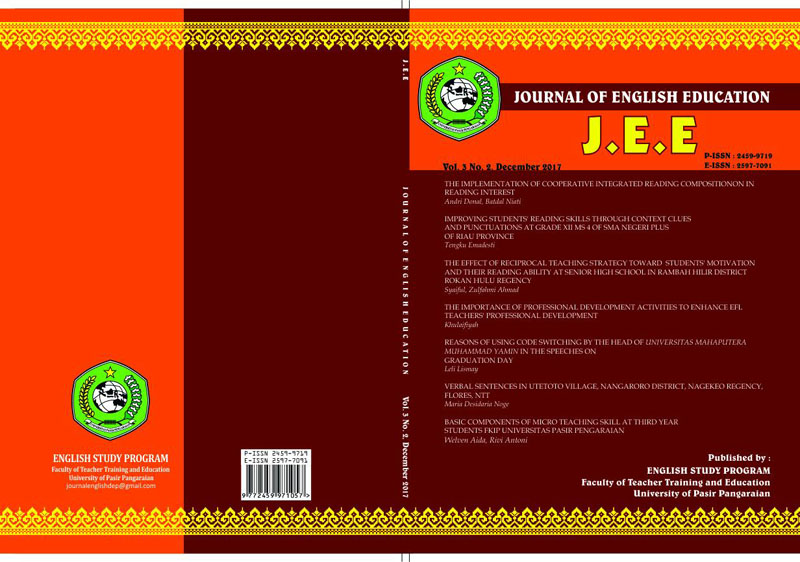THE EFFECT OF RECIPROCAL TEACHING STRATEGY TOWARD STUDENTS’ MOTIVATION AND THEIR READING ABILITY AT SENIOR HIGH SCHOOL IN RAMBAH HILIR DISTRICT ROKAN HULU REGENCY
Keywords:
reciprocal strategy, reading comprehension, motivationAbstract
Based on the result of the preliminary study, it was found that the students at SMAN 1 Rambah Hilir and SMAN 3 Rambah Hilir werelow score and not interested reading class. The students tendedto be passive inlearning process. Their reading comprehension mastery was low and they needed a long time to understand a reading text, even short text. The purpose of this study was to find out the effect of reciprocal teaching strategy toward students‟ motivation and their reading ability at senior high school in Rambah Hilir District Rokan Hulu regency. The design of this research was a quasi-experimental research with pre-test and post-test procedure. The data were collected through test and questionnaire. The total population was 61 students‟ of SMA Negeri 1 Rambah Hilir and 41 students‟ of SMA Negeri 3 Rambah Hilir. This research applied a random sampling technique to get samples. Then, the data were analyzed by using t-test method to find out whether there is significant difference between the experimental group taught by using Reciprocal teaching strategy as a treatment, and the control group taught conventionally. The research result, the writer found that significant probabilities was higher than 0.05 (> 0.05) in both paired sample t-test and independent sample t-test, it meantthat there is significant different on students reading comprehension in pre-test both classes and in post-test of both classes, and there is significant different on students‟ motivation before and after treatment of experimental class. Besides, the value of eta square of students‟ was 0.97 at SMAN 1 Rambah Hilir and 0.96 at SMAN 3 Rambah Hilir. It showed it gave significant effect toward students‟ motivation and their reading abilityReferences
Barret, Rebecca, Ann (2003). Reciprocal teaching as a platform for communicative activities in the secondary foreign language classroom: A case study. (Dissertation) Retrieved on May 7th 2014
Brown H. Doughlas (1996) Language Assessment. London Oxford University Press
Creswell, Jhon W. 2008. Educational Research (3rd Ed). New Jersey: Pearson Education, Inc.
Cohen, Manion, Morrison. 2000. Research Methods in Education .Routledge.
Doolittle, et al (2006) Reciprocal Teaching for Reading Comprehension in Higher Education: A Strategy for Fostering the Deeper Understanding of TextsInternational Journal of Teaching and Learning in Higher Education 2006, Volume 17, Number 2, 106-118 ISSN 1812-9129Retrieved on April 29th 2014 from http://www.isetl.org/ijtlhe/
Freman, Helen, 2009. The big issue: Reciprocal Reading. Retrieved on October 9th 2014 from http: //www.scholastic.co.uk/
Hughes, Arthur (2003) Testing for Language Teacher. Oxford University Press. Oxford
Nunan, David. 1999. Second Language Teaching and Learning. Boston: Heinle and Heinle
Palinscar, A. and A. Brown. 1984. Reciprocal teaching of comprehension-fostering and comprehension-monitoring activities. Cognition and Instruction, 1, 2. Retrieved: April 29th 2014 http://eca.state.gov/forum/vols/vol33/no4/p29.htm
Palinscar, A (1986) Reciprocal Teaching. Cambridge University Press
Pintrich, P.R., De Groot, E.V.: Motivational and Self-Regulated Learning Components of Classroom Academic Performance. J. of Ed. Psych. 82, 33–40 (1990)
Scholastic (2009)The big issues: Reciprocal Reading. retrieved: April 29th 2014 http://www.scholastic.co.uk/
Taylor, Jacky et al. 2005. Program Administrators’ Sourcebook; A Resource on NCSALL’s Research for Adult Education Program Administrators. Cambridge. NCSALL Inc..
Weir, Cyril J, (1990) Communicative Language Testing. University of Reading UK. English Language Teaching. Prentice Hall. London




